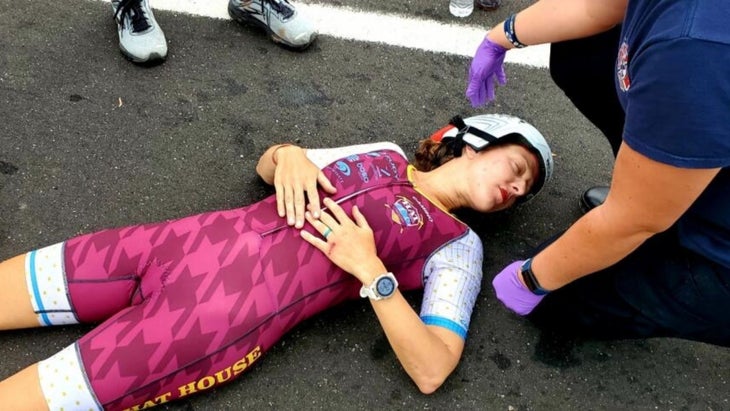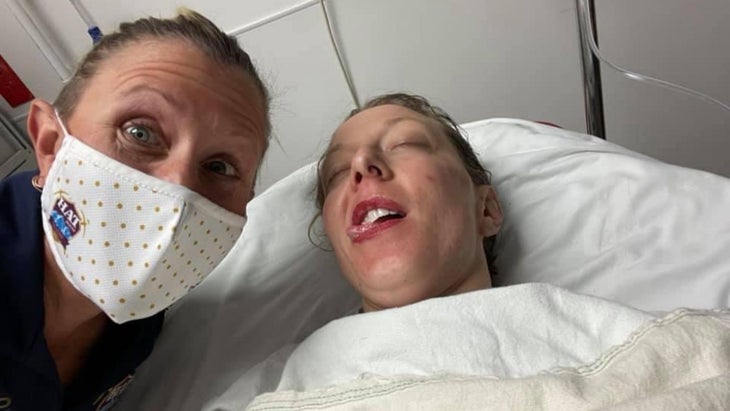New perk! Get after it with local recommendations just for you. Discover nearby events, routes out your door, and hidden gems when you sign up for the Local Running Drop.
When Emily Hippen and Tristen Rogers qualified for the Ironman 70.3 World Championship together at Steelhead 70.3 earlier this year, they immediately began making plans for a joint trip to St. George.
“We were in the same age group, and so excited to have both made the cut,” said Hippen. “We had been talking about this big race and planning our time in St. George for months.”
As members of the same triathlon team, HAT House Altitude Team in Denver, Colorado, the two were already frequent training buddies. But in St. George, they became more than that; they became close friends with an unbreakable bond. The pivotal moment came at mile 40 of the world championship race, when a freak storm blew through the course, bringing high winds, hail, and lightning. Approximately 70 age-group women who were still in the midst of the swim in Sand Hollow were pulled from the water; Hippen and Rogers were just a few miles into the bike leg.
“I was on a climb when I saw about 20 or 30 women just standing on the side of the road,” said Rogers. “I thought that Ironman was halting the race for our safety, until the worst of the storm passed, and was preparing to stop. But then realized, when I got to the top of the climb, that these women had voluntarily pulled over because they were literally being blown off their bikes and some looked fearful for their safety. The bike ride at that point instantly became one of survival, and not of performance.”
Rogers continued on, her knuckles white from the tight grip on her handlebars. After all, this was a world championship race— the first one since 2019—and she was determined to make it to the finish. Besides, she reasoned, the storm would surely pass.
Meanwhile, Hippen was just ahead of her teammate on the course (“I’d been pushing all day to stay ahead of her,” she said) with the same white knuckles. She, too, was waiting for the storm to pass, when she reasoned the ride would become much easier. Just before a pivotal turn in the course, Rogers finally laid eyes on her teammate—but not the way she expected.
“I heard a bunch of women ahead of me scream, and looked up and literally saw feet in the air and then a body hit the ground,” said Rogers. “It happened so fast.”

Rogers didn’t realize it was her teammate who she’d seen fly into the air until she stopped to give aid. Hippen was unconscious, her eyes rolled back in her head. While other athletes hurried ahead to alert medical authorities at the aid station, Rogers stayed with her friend. A volunteer arrived to assist, and Rogers gave what information she could—Hippen’s name, the name of her husband, and a phone number. When an ambulance arrived minutes later, Rogers was thanked for her help and told she could resume her race. Though the storm had finally passed by then, she couldn’t bring herself to finish the race. After riding her bike back into town, she turned in her timing chip, racked her bike, and immediately headed for the hospital.
Hippen, thankfully, was fine—banged up, to be sure, but expected to make a full recovery. In her post-crash fog, she was especially surprised to see Rogers.
“Tristen stayed with me at the hospital, helped my husband get there, picked up my prescriptions, and got me back to our Airbnb,” Hippen said. “She did it all. All while she could have been finishing a race that was very important to her.”
For Rogers, taking the DNF wasn’t a difficult decision. “I don’t think I would have been happy with myself had I not stopped. I want to promote all things good about being a positive member of our endurance community,” she said. “On our team website, one of the examples we have for people who are interested in joining is, ‘If you wouldn’t stop and help someone on the side of the road because it is going to mess up your data/Strava/personal record, then we probably are not the team for you.’”
While Hippen recovers, she’ll be cheering on her friend who plans to finish her race via a self-supported 70.3 in Denver. The two have plans to qualify again for 70.3 Worlds and, this time, to finish together.
“Tristen is a model athlete,” said Hippen. “Being a champion is so much more than crossing the finish line ahead of others. It means being a champion of fellow athletes and giving selflessly to others. And Tristen is a true champion.”

